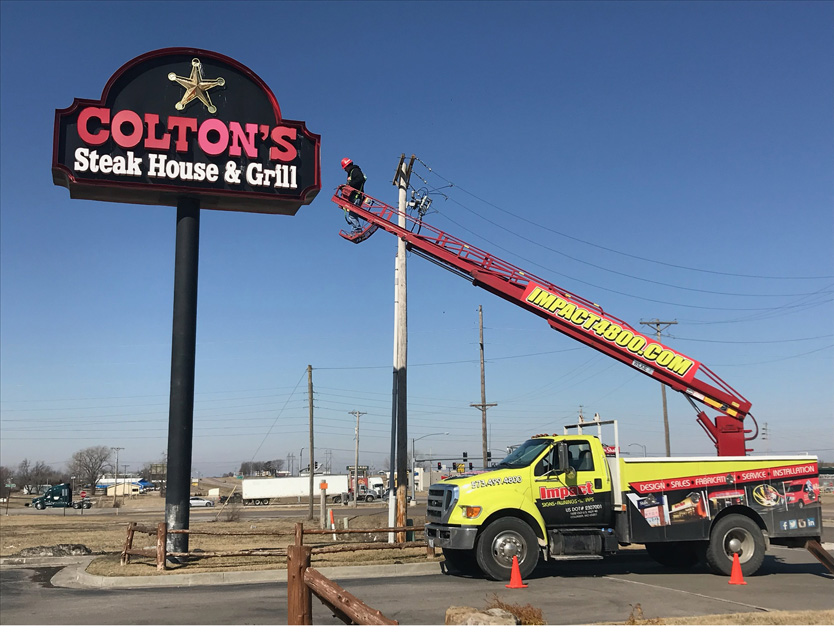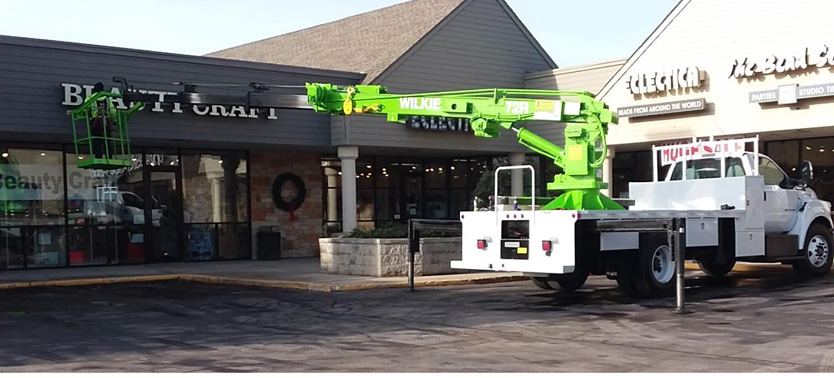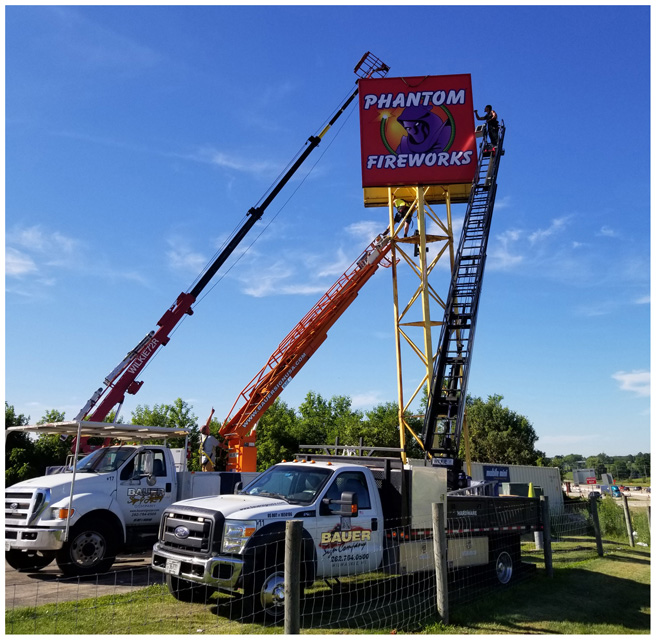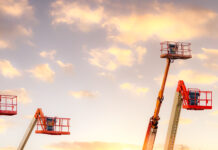Telescoping equipment such as bucket trucks and aerial work platforms are essential tools for sign makers needing to get up to a roofline or atop a structure to either set up a brand-new sign or service an existing one. However there are several steps workers can perform when using these vehicles to help set them up to return to the ground safe and sound and be able to venture out to the next aerial job.
If using a bucket truck or aerial work platform (AWP) to transport signage up in the air, Jim Troe, general manager of Van Ladder, advocates securing said signage to specialized forks and platforms on the outside of the bucket so that the sign is in the proper install orientation before the bucket ever leaves the ground. “Why lift the sign twice?” he says. “For this reason, we’ve designed both upper and lower rotating forks (along with securement braces), giving the operator the ability to place the sign on a wall and maintain hands-free access to their work.”
Meanwhile Troe says that his company builds a one-person lift and utilizes accessories to give the operator a second set of hands in the bucket. “This frequently eliminates the need to have two people in the air (at least for installations of 200 pounds or less),” he says. “The second person can work on the ground—unpacking crates, preparing the wiring, assembling the signage, and loading the forks.”

Troe adds that wearing a fall arrest harness is a necessity when working on an AWP or inside a bucket. Securing the load while handling materials is also critical. “Since many signs are located right above the front door of a business, dropping things isn’t an option,” he says. “An installer trying to hold the weight of the sign with one hand while using a power tool with the other isn’t in a very good position to react to shifting loads, wind gusts, or a variety of other variables.
“It’s always best to have one hand free and both feet securely planted on the floor of the bucket.”
Not only should your employee be safe but so too should any pedestrians or vehicles on the ground below. “Highly visible cones should be set up to direct them around your aerial work,” says Troe. “Even something as small as a tape measure could injure a person walking beneath an elevated bucket or platform.”
When it comes to ladder trucks, Bryan Wilkerson, vice president of Wilkie Mfg., states that, while they were designed around the servicing of signage and thus revolutionized this side of the industry, these configurations also work well for installation. “Ladder trucks act as support vehicles to help personnel get safely elevated to set a sign in place and do the final bolt-in or weld-in, along with all of the accompanying hook up,” he says, noting these vehicles are also commonly used in sight surveys because of their easy maneuverability and quick set up.

While using a telescoping ladder truck to transport signage up to a rooftop or pylon safely might seem vertically challenging to some, these actions can still be done—with important things to keep in mind. “Ladders have a limited weight capacity of 325 pounds (including the operator),” says Wilkerson. “They also don’t have a load line or lift attachment points, so if the weight allows, signage could be placed in the ladder behind the operator, which would allow an unobstructed view of the work area.”
Wilkerson comments that one advantage a telescoping ladder has in relation to servicing needs over a traditional elbow bucket is its ability to scope directly out to the work area without having to concentrate on where the secondary arm is located. “If working off to the side in a bucket truck, you should be aware that the secondary arm can protrude into traffic,” he says.
As for stability advice, Wilkerson suggests, “If the ladder is going to be out of the cradle, the outriggers need to be set, if so equipped. Some small ladder units rely on a ballast weight or torsion bar system.”
Wilkerson states that outriggers should be placed per the manufacturer’s recommendations, noting that (on Wilkie units, at least) this would be on firm ground with outriggers slightly raising the bed until it is level with the tires on ground. “Additional leveling may be needed for trucks using a ballast or torsion bar system when used on a grade, as tilting the truck may change its center of gravity,” he adds.
When working in a bucket or an AWP, Troe says to be mindful of load capacity and parking slope. “When maximizing side reach, set rotation on low speed,” he says. “This takes the jerkiness out of bucket travel when feathering into position.”

Wilkerson says that safety factors for ladder trucks run the same as with any other aerial-related service equipment. It’s most important to remain aware of your work area and hazards that you may—or might—encounter. “The main ones for the sign industry are overhead powerlines, fall protection, vehicles intruding into the work area, improper lock out tag out,” he says.
Efficiency has proven a keyword in AWP and ladder truck designs. “Signs have also gotten a lot lighter as most all signs are made from aluminum and plastic or flex faces with LEDs and low-watt transformers,” says Wilkerson, adding that his company anticipated this change several years ago and it’s one of the reasons why they started the XRB family. “We also have changed the way the beds and bodies are laid out to be more efficient for the people in the sign industry.”
A yearly inspection is required by OSHA under 1926.453, however there isn’t really any suggested maintenance-tips-after-every-job that’s recommended for bucket trucks and AWPs. Wilkerson counters that it’s actually more important to address certain things before going out to the job site. “Every day should start off with a full visual inspection of the equipment before it ever leaves the yard,” he says. “Any problems should be notated in writing and the problem addressed before the equipment is used.
“You should also have a weekly and monthly inspection.”
—Jeff Wooten










